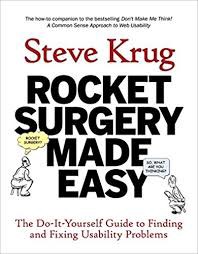Rocket Surgery Made Easy

This book is all about Usability Testing and builds upon the basics covered in Don’t Make Me Think that I covered last week. I really loved Steve Krug’s writing style. He does an excellent job of keeping you entertained and making sure you actually finish the book. I was in awe of how excellent writing makes a world of difference when it comes to presenting a topic that otherwise could have been pretty bland. Here are my notes from the book:
Usability Testing
When it comes to usablity testing, any testing with anyone is better than no testing, and a bit of testing earlier is better than a lot of testing later. Steve calls this kind of testing “Do It Yourself Usability Testing” since it’s supposed to be cheap, easy-to-do and takes just a morning a month. Here are some of Steve’s recommendations:
- Reserve one morning a month (say the third Thursday every month) for a round of testing, debriefing, and deciding what to fix.
- Test with three participants each round. Recruit loosely, and grade on a curve — you don’t need to find someone who fits the exact mold of your users since most usability problems can be uncovered by testing with just about anyone.
- Get as many people as possible to observe the tests — the designers, engineers, project managers, executives etc.
What happens during the test?
During a usability test, you will record the participant’s voice and the screen, as well as share both live with observers in another room. A typical one-hour test can be broken down into:
- Welcome (4 mins): Explain how the test will work so that the participant will know what to expect.
- The questions (2 mins): Ask the participant a few questions about themselves. This helps put them at ease and gives you an idea of how computer-savvy they are.
- The Home page tour (3 mins): Open the Home page of the site you’re testing, and ask the participant to look around and tell you what they make of it. This will give you an idea of how easy it is to understand your home page, as well as how familiar the participant is with your domain.
- The tasks (35 minutes): Watch the participant perform a series of tasks you have prepared for them beforehand. Encourage the participant to think out loud, and it’s crucial that you let them work on their own and not ask them any leading questions, or give out any clues or assistance.
- Probing (5 mins): Ask the participant any questions you may have about anything that happened during the test, and any questions that people in the observation room may have. Also, answer any questions that the participant may have at this point (don’t answer them during the actual tasks since your’re testing how they’ll perform with no one around)
- Wrapping Up (5 mins): Thank them for their help, and give them their gift card.
The Debriefing
During the breaks between successive tests, ask the observers to write down the top 3 usability problems that they see. During the debriefing, focus ruthlessly on deciding to fix the most serious problems first. Here are a few other recommendations:
- Keep a separate list of low-hanging fruit
- Resist the impulse to add things — instead try to tweak your existing design to fix the problem
- Take “new feature” requests with a grain of salt. Participants will often suggest new features, but when you probe them further, they themselves will admit that they more often than not themselves will use the features they are suggesting.
- Ignore the problems where the user goes astray for a bit, but comes back on track by themselves.
- Good design is a delicate balance, so when fixing a problem, ensure that you aren’t introducing new ones.
Remote testing and unmoderated user testing
Remote testing is very similar to Usability testing discussed above, except that the participant is at their home/office and you conduct the testing via screensharing and voice call. Unmoderated user testing is another cheap way to test, where you specify your website, the tasks you want the users to do, and get back video recordings of people trying to accomplish those tasks. While not as effective as a usability testing session you conduct in person, these are usually a lot less expensive.
Resources
You can download checklists, interview script, consent form, a demo video at Steve Krug’s site here: Downloads for Rocket Surgery Made Easy
Originally published at www.commonlounge.com.
This is #13 in a series of book reviews published weekly on this site.
